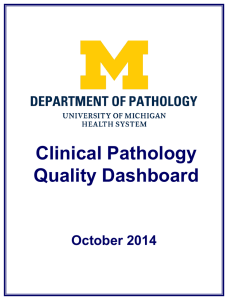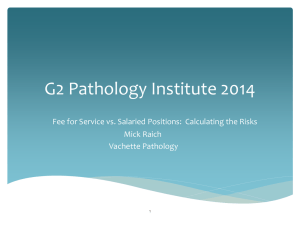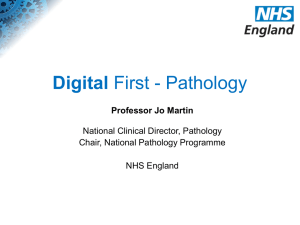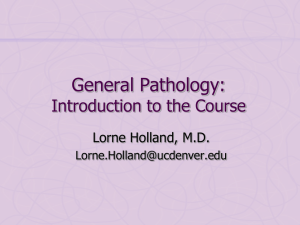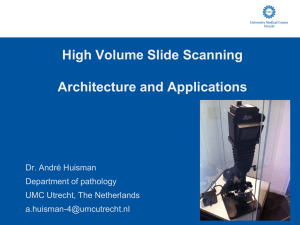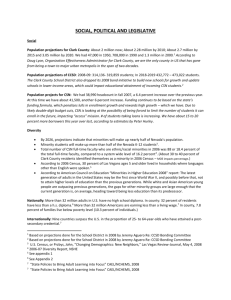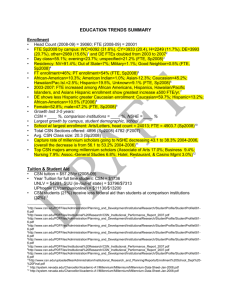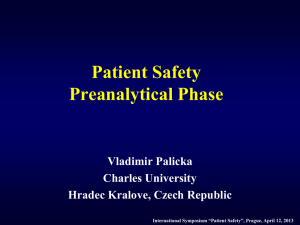November - Pathology
advertisement
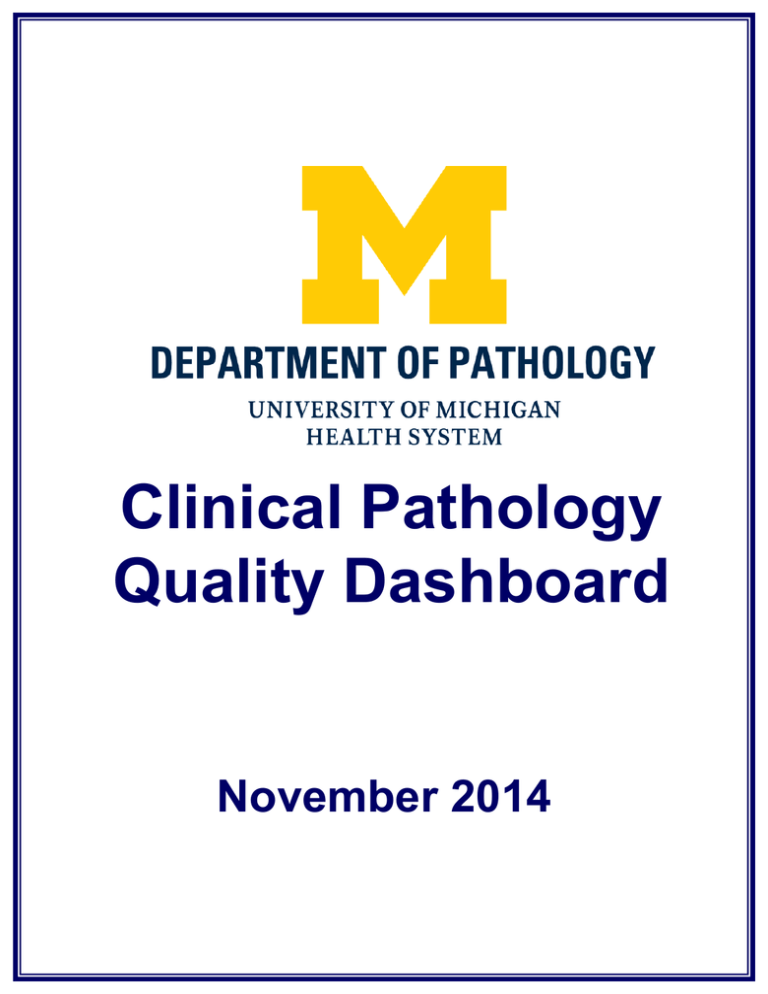
Clinical Pathology Quality Dashboard November 2014 Clinical Pathology Patient Care Quality Minutes Blood Bank The Blood Bank experienced an increase in TAT for Emergency Departments (ED=Adult, CES=Children’s) type and screen testing during the Soft go-live implementation starting in June 2013. As staff have gained more confidence using the new software and developed more efficient processes using the system, there has been a steady decrease in the TAT approaching pre-Soft conditions. The TAT goal is 60 minutes. Clinical Pathology Patient Care Quality Chemistry Description of Problem: The guaiac method for detecting blood in the stool as a detection of colorectal cancer requires the patient to adhere to several dietary restrictions as well as to collect three separate stool samples. Due to this complexity, we had low compliance (<20%). Newer methodologies such as FIT are available that only require a single sample, no dietary restrictions, and have a higher sensitivity. Impact of Problem: Formerly, the guaiac cards we distributed had a low rate of return as indicated above. Use of the newer immunochemical method has increased the rate of return almost four-fold due to ease of collection by the patient. Reporter of Problem: Laboratories, physician offices Description of Solution: Implement the immunochemical method for detection of colorectal cancer. Physicians would order the test when the kit was handed to the patient. Pre-stamped envelopes provided to the patient will be returned to the laboratory where the test will be run. How we know it worked: We continue to see a positive outcome relative to patient compliance with returning the kit for testing. For the past 6 months we’ve seen a 1-2% increase each month. Since November 2013 we have increased compliance by 40%. Issues related to the date of order, release & collection are being investigated by MiChart & Chemistry. Date Solution Implemented: October 29, 2013 Clinical Pathology Patient Care Quality Hematology Description of Problem: The Hematology lab created specific parameters related to the complete blood count (CBC) that reflex to the pathologist for a review starting in 2005. Impact of Problem: Inappropriate requests increase cost due to the additional pathologist review (pathrev) and impair the turnaround time for patients that require a pathologist review since there is no way to prioritize these if all of the slides are reviewed. Reporter of Problem: Hematology Pathologists/Staff Description of Solution: Alter the current policy based on medical director guidance to allow specially trained, competency assessed technologists to prescreen path-rev slides. If screens are determined to be inappropriate for pathologist review the path-rev would be canceled. How we know it worked? Over 40% of all path-rev orders requests received each month are canceled thus improving turnaround time and decreasing the cost to the institution and patient. Technologist decisions are assessed monthly. Approximately, 10 cases per month are reviewed rotated between 5 screener technologists. This equates to each technologist being assessed twice per year. Areas for continued improvement: On 11/10/14 the Hematology lab is implements the revised criteria to reflex the path-rev. They will monitor the outcome of these revisions moving forward via a spot-check QC process. Clinical Pathology Patient Care Quality Hematology Description of Problem: Historically, MD requests have been processed as ordered. During the past year, there has been an upward trend in the number of Pathology Review requests from providers. Investigation into why this is occurring and whether the requests are appropriate and could be triaged in other ways is in progress. Impact of Problem: Inappropriate requests result in the unneeded cost of Pathologist review and delay turnaround time for patients who require a pathologist to review their slide. Reporter of Problem: Hematology Pathologists/Staff Description of Solution: Alter the current policy and allow technologists to prescreen MD request slides similarly to the Path-rev process used for CBCs. This is done after an initial audit by a pathologist review of cases deemed not to require MD Path Review assures patient safety. If screens are determined to be inappropriate, the MD Path Review would be canceled by the technologist. How we know it worked? TBD-Plans for implementation are ongoing. 11/17/14 started to have technologists report out positive crystals (8 positives reported out). Areas for continued improvement: Hematology is investigating reasons why orders are received in error from providers (e.g. inappropriate standing orders, errant orders, or improper understanding of the order code). Example of improper ordering=for one day a single patient had 18 path review orders Clinical Pathology Patient Care Quality Microbiology URCC=urine culture UA=urinalysis UC=UA with reflex URCC if UA=positive Description of Problem: Rates of catheter associated urinary tract infections (CAUTI) are a metric benchmark for patient quality of care. The inpatient population is particularly prone to high rates of infection. The CCMU (6D) is a focus of attention due to their patient population and propensity for positive urine cultures. The NHSN (National Healthcare Safety Network) benchmark is 2.9 infections per 1000 catheter days. In 2013 the CCMU rate was 5.5. While investigating the CCMU, it was discovered that the rate was falsely elevated due to a large number of false positive cultures (>80% non-pathogen yeast with 20% of these indicating a negative urinalysis). Root Cause Follow-up Ordering cultures on asymptomatic patients Training for care providers on proper test utilization Collecting specimens from urine catheter bag not the catheter line Training implemented for nursing Delays in transport cause bacterial growth=false positives Use BD urine vacutainers for collections to increase storage time at room temp Urine cultures being “over worked” Modify protocols for urine specimens to be consistent with guidelines Areas for continued improvement: 1. Impact of Problem: Clinically irrelevant positive urine cultures can lead to additional testing and antibiotics, both of which may be unnecessary. Inefficient use of resources to process these specimens is also a concern. Reporter of Problem: CCMU, Microbiology leadership & Infection Control Description of Solution: Several countermeasures are being implemented or addressed. 2. Education facilitated by Infection Control appears to be assisting in ensuring the appropriate test is ordered. The number of UC (urine cultures reflexed from positive urinalysis screening) orders in the month of October was the highest recorded value since this project began. Therefore, cultures are only being ordered when indicated by a positive urinalysis screening for infection. The CCMU CAUTI rate has dropped to 4.5 since countermeasures have been implemented, however rates need to meet the NHSN benchmark of 2.9. Clinical Pathology Patient Care Quality Point of Care *Note Aug 2013 data decreased due to POC coordinator absence and RMPRO reports not entered during this time frame. * Once MiChart was implemented, a change occurred in how the patient was identified. In order to correlate billing information relative to the specific patient stay, the CSN number on the patient’s wristband is used rather than the MRN. The patient’s wristband was changed so that the glucometer CSN number is now a 1D barcode versus the MRN which is a 2D barcode. Since making this change, numerous errors have occurred where the MRN was manually entered by mistake into the RAALS laboratory middleware. The RAALS middleware requires the current CSN to function properly. Impact of Problem: The errors cause a delay in results being reported to the patient record. Additionally, the corrective action requires the POC Coordinator to match the misidentified patient results and then manually report them to the correct CSN. This opens the opportunity for human transcription errors along with inefficient use of the coordinator’s time to work on other tasks. Reporter of Problem: POC Coordinator & Nursing Leadership Description of Root Causes Identified: • Nursing is not able to access the barcode and has to manually enter CSN. Manual entry may be incorrect or the MRN (traditionally used for other tasks when identifying patients) may be used. This is especially true of pediatric wristbands which are smaller. Nurse educators have refocused training on this aspect. Investigation into modifying the patient wristband to allow more barcodes to be visible is ongoing by MiChart. • CSN mismatch-Examples of patients presenting at the ER or IPLV (Inpatient Like Venues) and then admitted on a different day (thus different CSN) still have their “old” wristband on which is no longer valid. Wristband printing-future visit day used to print wristband. Practice change by nursing to replace patient wrist band every time patient comes or returns to the floor (e.g. go to OR or procedure area and come back). • Identified reasons why nurses are manually entering MRNs and implementing countermeasures to address delays in downloading patient names & results to the patient’s record. • Modification of the wristband to limit the frequency of manually entered CSNs. Follow-up During the month of October there was an increase in the number of CSN-MRN mismatches. We will monitor this in the coming months to see if this is an aberrant increase or a true increasing trend for this error. Clinical Pathology-Current Projects **This is a highlight of projects ongoing in the CP labs. This list is not meant to be all inclusive of every activity occurring in the department. Project Brief Description Owner Customer Service/Call Center Address multiple issues related to providing an appropriate level of customer service for UMHS care providers. Dr. Newton ER Specimen Issues In coordination with the Emergency Department reduce the number of RMPRO specimen errors (e.g. hemolysis, mislabels etc.) S. Butch/K. Martin/T. Morrow Pathology Handbook Maintain and update the Pathology handbook to be a robust resource for our customers. K. Davis/K. Martin NCRC Planning Begin work to plan for the future state of the non-STAT Clinical Labs move to NCRC PRR Committee Clinical Laboratory News, Notes, and Kudos -----------------------------------------------------------------------------------•Labs that are working on process improvement projects that would like to display data can contact Kristina Martin (martkris@umich.edu) for future dashboards. Kudos • Congrats to Jeana Houseman & Peggy Mahlmeister who have assumed supervisory positions within the Microbiology laboratory. • Welcome to Kellen Kangas, who recently joined our team as Pathology’s Compliance Manager
